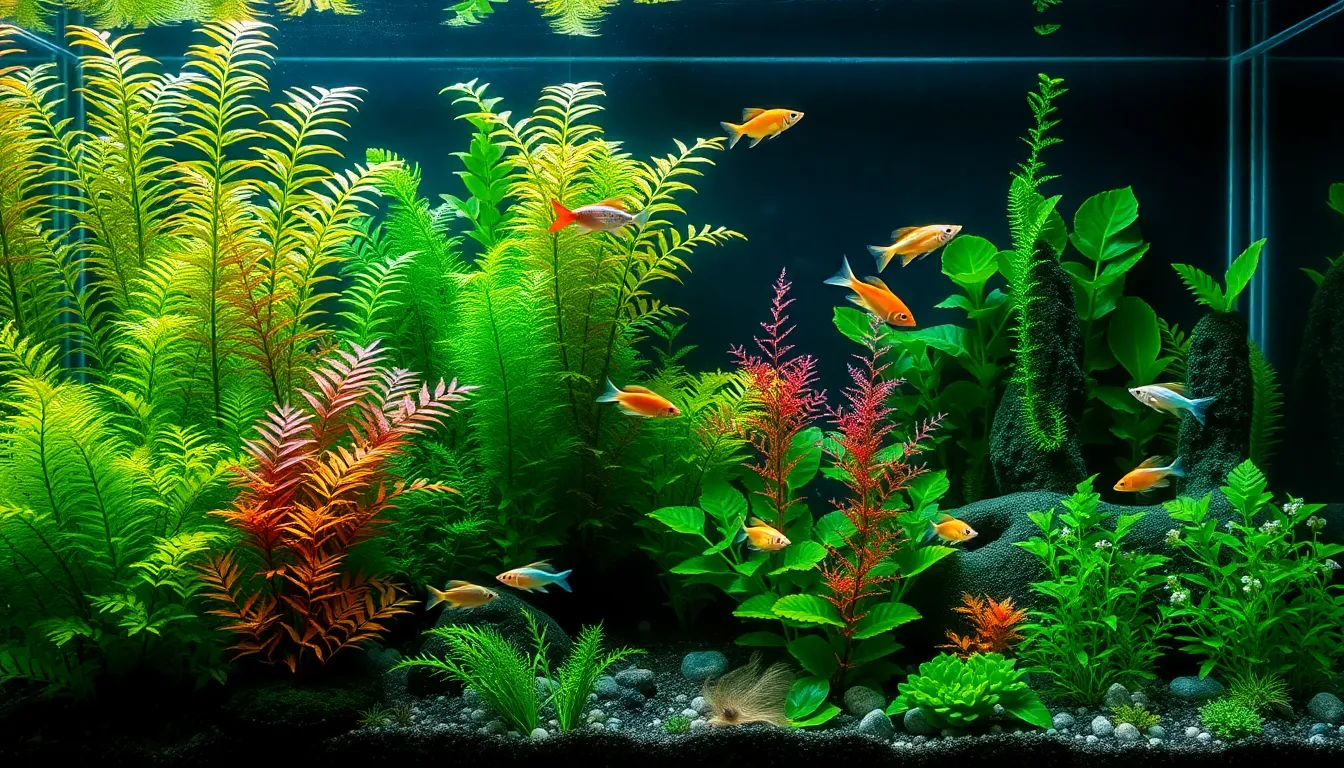In a world where plants and fish seem to occupy their own realms, a quirky phenomenon called plantifishitus is turning heads and raising eyebrows. Imagine a lush green aquarium bursting with vibrant foliage and swimming fish, all cohabiting in perfect harmony. Sounds like a dream, right? Well, this delightful blend of botany and aquaculture is more than just a whimsical idea—it’s a trend that’s making waves in the gardening and aquarium communities.
Plantifishitus isn’t just about pretty plants and fish swimming around; it’s a playful reminder of how nature can surprise us. With the right balance, anyone can create a stunning underwater garden that’s both a feast for the eyes and a conversation starter. So, grab your gardening gloves and your fishnet; it’s time to dive into the fascinating world of plantifishitus and discover how to bring a slice of this enchanting ecosystem into your home.
Table of Contents
ToggleOverview Of Plantifishitus
Plantifishitus represents a captivating blend of aquatic flora and fish. This phenomenon emphasizes not only aesthetic appeal but also the ecological balance within an aquarium. Various aquatic plants, such as Java fern and Anubias, thrive alongside fish species like guppies and tetras, creating vibrant ecosystems.
Aquatic plants contribute to water quality by absorbing nutrients, supporting fish health. They also provide shelter and breeding grounds for fish, enhancing the overall habitat. Observing fish among lush greenery fosters a sense of tranquility and connection with nature.
Creating a plantifishitus aquarium involves careful planning. Selecting compatible plants and fish is essential for a balanced environment. Regular maintenance ensures optimal conditions for both flora and fauna. Monitoring water parameters, like pH and temperature, helps maintain a stable ecosystem.
Design considerations play a significant role in plantifishitus setups. Arranging plants in layers creates depth, while choosing fish with varying colors adds visual interest. It’s important to consider lighting, as various plants require different levels of illumination.
This phenomenon also encourages creativity among aquarium enthusiasts. Each setup can be unique, showcasing individual styles and preferences. Engaging with plantifishitus allows enthusiasts to express themselves while promoting ecological awareness.
Ultimately, embracing plantifishitus enriches personal spaces and brings elements of nature indoors. Whether through hobbyist engagement or educational pursuits, the allure of plantifishitus continues to inspire.
Causes Of Plantifishitus
Plantifishitus results from a combination of environmental factors and genetic predispositions impacting organisms within aquatic ecosystems. Understanding these causes enhances the ability to create thriving underwater gardens.
Environmental Factors
Aquatic environments play a crucial role in the development of plantifishitus. Water quality significantly influences plant growth and fish health. Factors such as pH levels, temperature, and nutrient availability contribute to the success of this unique ecosystem. Algal blooms can result from nutrient overload, while excessive light can affect plant and fish dynamics. Maintaining optimal conditions fosters the harmonious interplay between plants and fish, leading to a balanced aquarium.
Genetic Predispositions
Genetic traits in both plants and fish affect how well they adapt in a plantifishitus setup. Specific plant species, like Java fern and Anubias, exhibit strong resilience to varying conditions. Fish species, such as guppies and tetras, also display adaptability and compatibility with these plants. Genetic factors determine growth rates, reproductive behaviors, and overall health, making these traits critical for a successful aquatic environment.
Symptoms Of Plantifishitus
Symptoms of plantifishitus vary among individuals and can manifest in distinct ways. Observing changes in fish behavior often indicates underlying issues. Signs such as lethargy or erratic swimming patterns may appear. Additionally, aquatic plants may show unusual growth patterns, including excessive wilting or discoloration.
Physical symptoms in fish might include body lesions or fin rot, which signal stress. Cloudy eyes can also occur, implying potential health problems. Leaf rot or algae overgrowth often accompanies deteriorating water conditions.
Aquarium enthusiasts may notice water parameter fluctuations, particularly concerning pH, temperature, or ammonia levels. Cloudy water can emerge, signaling organic imbalances. Unpleasant odors often arise due to decaying matter, emphasizing the importance of proper maintenance.
Changing water clarity can affect overall visual appeal. An increase in detritus or debris often indicates neglected cleaning practices. Uneven lighting may exacerbate growth issues in plants, leading to additional symptoms, including stunted growth.
Identifying these symptoms early fosters a proactive approach to maintaining aquarium health. Monitoring fish behavior and plant vitality helps prevent significant issues. Regular water testing addresses potential problems before they escalate. Observing plant responses in conjunction with fish behavior provides insight into the overall health of the aquatic environment. Implementing timely interventions enhances the success of a plantifishitus setup and uplifts the enjoyment of the aquarium experience.
Treatment Options For Plantifishitus
Various treatment options exist for managing plantifishitus, focusing on both medication and lifestyle adjustments.
Medication Approaches
Medications help address infections and ailments in both plants and fish. Antibacterial treatments, such as erythromycin, target fish diseases like fin rot and body lesions. Additionally, antifungal solutions combat fungal infections that affect aquatic plants. Using medications correctly requires understanding specific symptoms before applying treatment. It’s crucial to read dosage information thoroughly to avoid harming the delicate balance within the aquarium. Regular monitoring ensures that the chosen medications effectively alleviate the issues without causing unwanted side effects.
Lifestyle Changes
Making lifestyle changes significantly impacts the overall health of a plantifishitus environment. Ensuring consistent water parameters, such as temperature and pH, fosters a stable habitat for both plants and fish. Adding regular maintenance routines, including water changes and substrate cleaning, enhances water quality. Incorporating natural filtration methods, such as live plants, improves oxygen levels and reduces harmful substances in the water. Implementing a diverse diet for fish promotes stronger immune systems. Adapting feeding schedules can also reduce waste and maintain clean conditions. Each adjustment contributes to a thriving, balanced aquarium ecosystem.
Prevention Strategies
Maintaining a balanced plantifishitus aquarium requires proactive measures to ensure health and vitality. Regular water quality testing prevents harmful fluctuations in pH, temperature, and ammonia levels. Testing kits provide reliable data on these parameters, helping hobbyists make informed adjustments.
Monitoring fish behavior offers early insights into potential issues. Observing for signs of lethargy or erratic swimming can indicate stressors in the environment. Promptly addressing these changes prevents further complications.
Selecting compatible species minimizes stress and promotes harmony. Researching fish and plant pairings ensures a well-balanced ecosystem. For example, pairing guppies with Java ferns enhances both visual appeal and ecological stability.
Keeping a consistent maintenance routine contributes to long-term success. Performing regular water changes helps eliminate harmful toxins and replenish essential nutrients. A weekly schedule for this task supports stable conditions that foster growth.
Including diverse species further enhances ecological balance. Adding a variety of plants, such as Anubias alongside mosses, creates a resilient environment. This diversity also enriches the aesthetic, creating a vibrant underwater garden.
Implementing proper lighting techniques promotes healthy plant growth. Understanding the specific light needs of different species can yield lush greenery. Using high-quality LED lights provides adequate illumination while minimizing energy consumption.
Finally, educating oneself about specific needs of both plants and fish supports informed decisions. Resources such as online forums and local clubs offer invaluable advice from experienced aquarists. Engaging with the community furthers knowledge and fosters a supportive environment for all enthusiasts.
Plantifishitus offers a captivating way to blend the beauty of aquatic plants with the lively presence of fish. This enchanting trend not only enhances the aesthetic appeal of aquariums but also fosters a deeper connection with nature. By understanding the delicate balance of ecosystems and the importance of proper maintenance, aquarium enthusiasts can create thriving underwater gardens that reflect their unique styles.
With ongoing education and community support, individuals can navigate the challenges of plantifishitus while enjoying the tranquility it brings. Ultimately, embracing this phenomenon enriches personal spaces and inspires a greater appreciation for the wonders of aquatic life.



